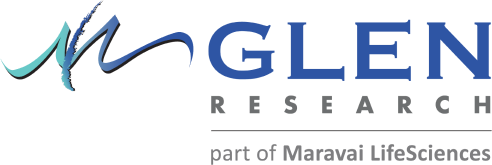Yakima Yellow® CPG - (20-5921)
3-(5,6,4',7'-tetrachloro-5'-methyl-3',6'-dipivaloylfluorescein-2-yl)-propanamido-1-(2-O-dimethoxytrityloxymethyl)-pyrrolidin-4-yl-succinoyl long chain alkylamino-CPG
3-(5,6,4',7'-tetrachloro-5'-methyl-3',6'-dipivaloylfluorescein-2-yl)-propanamido-1-(2-O-dimethoxytrityloxymethyl)-pyrrolidin-4-yl-succinoyl long chain alkylamino-CPG
Glen Research’s agreement with ELITechGroup, formerly Epoch Biosciences, allows us to offer several of their proprietary products designed for the synthesis of novel DNA probes. We are pleased to offer products based on ELITechGroup’s Redmond Red®, Yakima Yellow® and AquaPhluor® 593 fluorophores and Eclipse® non-fluorescent quencher. Under our agreement we also supply PPG, a modified nucleoside, and 5’-Aldehyde-Modifier C2 Phosphoramidite. The fluorescent dyes, Yakima Yellow, Redmond Red and AquaPhluor 593, are available as phosphoramidites and supports. Yakima Yellow has an absorbance maximum at 530 nm and emission maximum at 549 nm, Redmond Red’s absorbance and emission maxima are at 579 nm and 595 nm, respectively, and AquaPhluor 593 has an absorbance maximum at 593 nm and emission maximum at 613 nm. The fluorescein alternative, Gig Harbor Green, has been discontinued. The Eclipse quencher from ELITechGroup solves most of the problems inherent in the synthesis of molecular beacon and FRET probes. The Eclipse molecule is highly stable and can be used safely in all common oligo deprotection schemes. The absorbance maximum for Eclipse Quencher is at 522 nm, compared to 479 nm for dabcyl. In addition, the structure of the Eclipse Quencher is substantially more electron deficient than that of dabcyl and this leads to better quenching over a wider range of dyes, especially those with emission maxima at longer wavelengths (red shifted) such as Redmond Red and Cyanine 5. In addition, with an absorption range from 390 nm to 625 nm, the Eclipse Quencher is capable of effective performance in a wide range of colored FRET probes.
The spectral characteristics of this dye is detailed here.
Usage
- Coupling: This support should be used in a manner identical to normal protected nucleoside support since it contains the DMT group.
- Deprotection: Use ammonium hydroxide and deprotect as required by nucleobases. When using AMA, a small amount of a non-fluorescent impurity will be formed. To eliminate this impurity, first deprotect with ammonium hydroxide for 30 minutes at room temperature, add an equal volume of 40% methylamine and then complete the deprotection as required by the nucleobases - e.g. 10 minutes at 65°C or 2 hours at room temperature for standard bases.
| Specifications | |
|---|---|
| Recommended Storage | Freezer storage, -10 to -30°C, dry |
The table below show pack size data and, for solutions, dilution and approximate coupling based on normal priming procedures.
ABI 392/394
| Catalog # | Pack Size | Grams/Pack | 0.1M Dil. (mL) | Approximate Number of Additions | |||||
|---|---|---|---|---|---|---|---|---|---|
| LV40 | LV200 | 40nm | 0.2μm | 1μm | 10μm | ||||
| 20-5921-01 | 0.1 g | .1grams | 1 | 1 | 1 | 1 | 1 | 1 | 1 |
Expedite
| Catalog # | Pack Size | Grams/Pack | Dilution (mL) | Approximate Number of Additions | ||||
|---|---|---|---|---|---|---|---|---|
| Molarity | 50nm | 0.2μm | 1μm | 15μm | ||||
| 20-5921-01 | 0.1 g | .1grams | 1 | 1 | 1 | 1 | 1 | 1 |
CoA search tool
Please see Extinction Table
REFERENCE(S) Oligonucleotide Properties Calculator
To request a quote for products:
- Click “Contact Us” in the header bar above;
- Click “Customer Service”;
- Complete the form and provide the following information in the “Comments” section: note you would like a quote, item number (SKU) and quantity;
- Click “Submit”.








